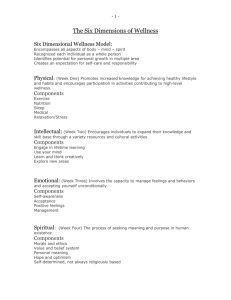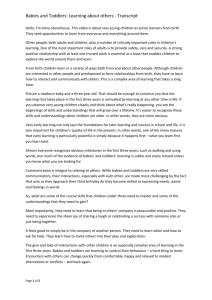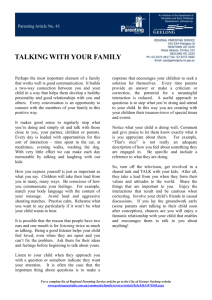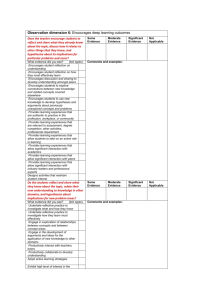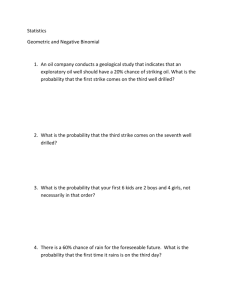Theme: Communicating
advertisement
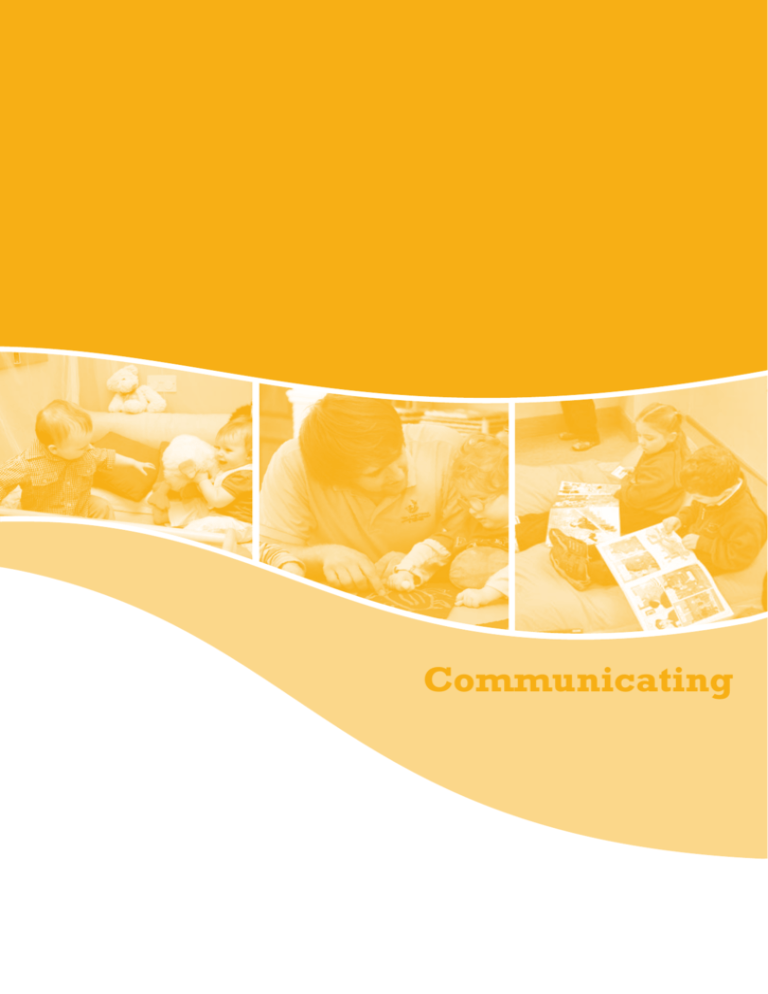
Communicating Aistear: the Early Childhood Curriculum Framework Communicating Theme: Communicating The theme of Communicating is about children sharing their experiences, thoughts, ideas, and feelings with others with growing confidence and competence in a variety of ways and for a variety of purposes. Communicating involves giving, receiving and making sense of information. Children do this by using nonverbal means of communication, talking, listening, thinking, and understanding. In time, the skills of reading and writing enrich this experience. Communicating is a two-way activity; as well as learning to share their experiences with others children also learn to interpret what others are sharing with them. They communicate in many different ways including facial expressions, gestures, body movements, sounds, language and for some children, through assistive technology. Children’s language is more than words, phrases and sentences. It includes art, Braille, dance, drama, music, poetry, pictures, sculpture, signing, and stories. While most children eventually master spoken and written language as their key means of communicating, they continue to speak through their gestures, body movements and expressions to a greater or lesser extent. Some children with special educational needs may need additional and consistent support throughout their lifetime to practise, learn and perfect the art of non-verbal communication. Being a good communicator is crucial to children’s development. The adult encourages children to communicate by listening to them, interpreting what they are saying, responding to them, and by modelling good communication. The adult also provides an environment which motivates children to interact with each other and the adult, and with the objects and places in it. By capturing children’s interest and curiosity and challenging them to explore and to share their adventures and discoveries with others, this environment can fuel their thinking, imagination and creativity, thereby enriching communication. These early experiences support children in becoming confident and competent communicators. 34 Aistear: the Early Childhood Curriculum Framework Communicating Table 3: Aims and learning goals for Communicating Communicating Aims Learning goals Aim 1 Children will use non-verbal communication skills. In partnership with the adult, children will 1. use a range of body movements, facial expressions, and early vocalisations to show feelings and share information 2. understand and use non-verbal communication rules, such as turn-taking and making eye contact 3. interpret and respond to non-verbal communication by others 4. understand and respect that some people will rely on non-verbal communication as their main way of interacting with others 5. combine non-verbal and verbal communication to get their point across 6. express themselves creatively and imaginatively using non-verbal communication. Aim 2 Children will use language. In partnership with the adult, children will 1. interact with other children and adults by listening, discussing and taking turns in conversation 2. explore sound, pattern, rhythm, and repetition in language 3. use an expanding vocabulary of words and phrases, and show a growing understanding of syntax and meaning 4. use language with confidence and competence for giving and receiving information, asking questions, requesting, refusing, negotiating, problemsolving, imagining and recreating roles and situations, and clarifying thinking, ideas and feelings 5. become proficient users of at least one language and have an awareness and appreciation of other languages 6. be positive about their home language, and know that they can use different languages to communicate with different people and in different situations. Aim 3 Children will broaden their understanding of the world by making sense of experiences through language. In partnership with the adult, children will 1. use language to interpret experiences, to solve problems, and to clarify thinking, ideas and feelings 2. use books and ICT for fun, to gain information and broaden their understanding of the world 3. build awareness of the variety of symbols (pictures, print, numbers) used to communicate, and understand that these can be read by others 4. become familiar with and use a variety of print in an enjoyable and meaningful way 5. have opportunities to use a variety of mark-making materials and implements in an enjoyable and meaningful way 6. develop counting skills, and a growing understanding of the meaning and use of numbers and mathematical language in an enjoyable and meaningful way. Aim 4 Children will express themselves creatively and imaginatively. In partnership with the adult, children will 1. share their feelings, thoughts and ideas by story-telling, making art, moving to music, role-playing, problem-solving, and responding to these experiences 2. express themselves through the visual arts using skills such as cutting, drawing, gluing, sticking, painting, building, printing, sculpting, and sewing 3. listen to and respond to a variety of types of music, sing songs and make music using instruments 4. use language to imagine and recreate roles and experiences 5. respond to and create literacy experiences through story, poetry, song, and drama 6. show confidence in trying out new things, taking risks, and thinking creatively. 35 Aistear: the Early Childhood Curriculum Framework Communicating Sample learning opportunities Babies The adult ■■ ■■ ■■ ■■ interacts non-verbally with babies and uses appropriate and supportive techniques to encourage communication: ➜■ establishes and maintains eye contact with babies, speaks to them when interacting, and pauses giving them a turn ➜■ repeats babies’ sounds and uses infant-directed speech when talking to them (using a distinctly higher pitch, short phrases, simple words, a slow pace, and long vowels) ➜■ models non-verbal strategies to share feelings, for example using wide eyes to show amazement or wonder, smiling and clapping hands to show delight ➜■ interprets and responds to babies’ sounds, expressions and body movements, for example soothing babies, verbalising their intentions, responding to gestures with words, and pointing to things ➜■ watches for signs that babies are concentrating on something they see, hear, feel, or taste, and models conversation by asking simple questions and providing answers provides opportunities for babies to learn language from others: ➜■ enables babies to watch and listen to adults and other children ➜■ encourages other children to speak to and play with babies so they hear sounds, words and sentences being used ➜■ repeats the names of other children around babies and describes what they are doing creates a print-rich environment and fosters babies’ enjoyment of books: ➜■ shares a variety of books including babies’ favourite ones, and encourages them to lift flaps, feel textures, and press buttons to hear sounds ➜■ looks at and talks about pictures and photographs that link to babies’ experiences ➜■ provides ‘talking’ toys for play ➜■ describes and comments on what is happening around them, for example noises, colours, weather, and activities ➜■ displays photographs of the babies’ with their names beside them supports language development using stories, games, songs, and rhymes with actions, finger movements and visual props: ➜■ repeats words, songs and rhymes often so that babies become familiar with sounds ➜■ reads and enjoys stories with babies ➜■ uses culturally appropriate props such as dolls, puppets, dress-up items, everyday objects, exaggerated gestures, and movement to stimulate babies’ senses when telling stories and nursery rhymes ➜■ involves babies in ‘saying’ rhymes, for example pausing and waiting for the babies to imitate an action or to make a sound for a familiar line or word in a rhyme ➜■ speaks key words and phrases using babies’ home language where this is neither English nor Irish (asking parents for help in doing this) 36 Aistear: the Early Childhood Curriculum Framework ■■ ■■ Communicating fosters listening skills using voice tone, music, movement, songs and rhymes: ➜■ plays listening games focusing on particular sounds or patterns of sound ➜■ uses the human voice where possible, rather than recordings, to introduce songs, poems and rhymes ➜■ sings songs slowly leaving gaps which invite babies to join in ➜■ moves to the beat of the music and helps babies to do the same ➜■ provides a variety of ‘home-made’ and ‘real’ musical instruments for babies to play with supports creative expression: ➜■ encourages babies to explore a range of materials, for example painting with their hands, playing with bubbles, crawling on fabrics of different textures ➜■ plays a variety of music and encourages babies to respond, for example claps, taps on the head or hand, waves, screeches, moving quickly to music with a fast tempo ➜■ provides playthings of different sizes, colours, shapes, and textures, and describes their features, for example, I see you’ve got the fluffy cat. Cia, look at the yellow star. Toddlers The adult ■■ ■■ ■■ supports toddlers in developing their language: ➜■ names familiar objects and describes experiences ➜■ over time, introduces new words in context, and models using more complex language structures, for example adding descriptive words: The snail crawled slowly. The big giant was very hungry. Tony is sad because his pet hamster is sick. ➜■ shows the meaning of words by linking to children’s actions and experiences ➜■ encourages toddlers to use their home language (when this is neither English nor Irish) in the setting, for example to say a rhyme creates a print-rich environment and fosters toddlers’ love of, excitement in, and understanding of books: ➜■ reads, enjoys and explores stories ➜■ invites toddlers to ‘read’ stories using pictures ➜■ models how to use English and Irish books—right-way up, left to right on the page ➜■ provides toddlers with opportunities to discuss, think, predict, suggest, recount, and speculate about what will happen next in stories and poems and why ➜■ encourages toddlers to make marks, for example writing with crayons, painting and printing, working with chalks encourages toddlers to communicate creatively through story, song, sculpture, rhyme, play, music, dance, and art: ➜■ through pretend play, retells and adapts stories read and experiences lived, for example toddlers creating a den where the animals sleep at night, making a ‘bus’ and setting off on a journey collecting passengers on the way, setting up a vet’s surgery where they treat their sick pets, constructing a fishing port where they land and sort their catch 37 Aistear: the Early Childhood Curriculum Framework ■■ Communicating ➜■ provides materials and helps toddlers design and make musical instruments from ‘junk’ materials, and encourages toddlers to use these to make music imitating a steady beat ➜■ encourages toddlers to listen to and respond to music, for example tapping, swaying, moving to the beat ➜■ describes and makes facial expressions to explain how pieces of music make them feel ➜■ provides a variety of art materials and play props for children to use in sharing their thoughts, feelings and ideas counts and uses mathematical language in everyday situations: ➜■ counts with the children as part of daily routines, for example, How many aprons do we need to have for everyone to bake our bread? Let’s count together. I see you have lots of tools in your workshop. How many nails are you hammering into that piece of wood? Do we have enough chairs and beds for the seven dwarfs? ➜■ uses everyday moments to enrich toddlers’ understanding of number, for example putting one paintbrush in each paint-pot, giving a story-book to each child, checking each toddler has a doll in the buggy to go for a walk, using numbers when creating patterns with paint or toys, for example a traffic-jam of cars—one red car, one yellow car, one red car, one yellow car ➜■ explores the characteristics of objects, and notices similarities and differences, for example the colour, height and size of flowers in the garden or park, the size, shape and colour of shells or stones ➜■ helps toddlers to share with others, for example giving playdough to each of four children or dividing a mandarin orange into segments and sharing with a friend, sharing wheelie toys among a group of children ➜■ enjoys finger games and nursery rhymes involving counting ➜■ provides activities to help toddlers understand positional language such as up, down, in, out, behind, in front, over, under, and describes these as the toddlers experience them. Young children The adult ■■ encourages young children to develop their non-verbal communication: ➜➜ creates opportunities for children to respond to literary experiences using facial expressions and body movements, for example showing feelings through facial expressions as they arise in a poem or story being read aloud by the adult, using body movements and actions to respond to a tongue twister or a song ➜➜ models non-verbal rules such as taking turns, and encourages children to use these in their interactions with others ➜➜ demonstrates empathy in response to children’s non-verbal reactions to stories and experiences and encourages children to ‘read’ each other’s expressions and body language 38 Aistear: the Early Childhood Curriculum Framework ■■ ■■ ■■ Communicating helps young children in developing their listening skills: ➜■ encourages children to play group games, for example, games that involve listening to, memorising, and adding to lists such as a shopping list, I went to the shop and I bought a loaf of bread, a litre of milk, a tin of beans… ➜■ provides opportunities for children to listen to a variety of sounds in their environment, and to describe and identify them ➜■ invites children to focus on features of pieces of music, for example fast/slow, high/low and loud/soft, and to share these through discussion, movement and art ➜■ encourages children to listen to each other tell and read stories ➜■ works with children to decide on ‘how we listen’ in order to promote an atmosphere of respect for each other’s contributions encourages young children to think and talk about their own and others’ feelings: ➜■ uses the language of feelings: I feel happy today because … I was so cross when … I got scared yesterday ‘cos … ➜■ models admitting making mistakes and saying sorry ➜■ encourages children to use pretend play to work through emotions such as worry, fear and jealousy; providing lots of props, dress-up clothes and equipment to help with this ➜■ encourages young children to talk about and/or draw pictures of what they like/don’t like doing ➜■ encourages children to recognise their strengths and things that they find easy and difficult to do ➜■ invites children to draw comic strips or provides pictures to sequence stories about feelings ➜■ reads and discusses books which reflect a range of emotions, such as empathy, discrimination, equality, and fairness supports young children in developing their language: ➜■ models good use of language while providing children with lots of opportunities for speaking and listening (especially important for children learning English or Irish as a second language) ➜■ listens to young children attentively and takes their ideas seriously ➜■ provides opportunities for children to talk to different people in one-to-one, small group, and large group situations, for example children saying a nursery rhyme with a friend or telling their news about something they did together, children interview a member of their community ➜■ encourages children to plan, predict and speculate about future or imaginary experiences particularly during pretend play ➜■ plays language games with children, for example I spy ➜■ finds and creates words that rhyme including nonsense words, such as man, tan, ban, dan, chan, wan ➜■ says tongue twisters ➜■ reads stories with children and explores characters and events in them 39 Aistear: the Early Childhood Curriculum Framework ■■ ■■ Communicating ➜➜ draws on new words from the story and models their use in a meaningful way ➜➜ encourages the children to think and talk about why things happened as they did in the story ➜➜ encourages children to retell and sequence stories and explore topics arising from the stories such as fairness, fear, friendship, bullying, and being safe ➜➜ asks open-ended questions and makes statements to encourage children to think aloud, wonder and explore possibilities with the adult, for example What is a friend? I wonder are fairies real. Being scared makes me go cold! How do aeroplanes stay up in the sky? ➜➜ draws children’s attention to letters and their sounds as part of their daily activities, play and routines ensures young children experience a print-rich environment and fosters their love of, excitement in, understanding of, and use of books: ➜■ provides young children with frequent opportunities to play with and read books ➜■ organises visits to the library ➜■ reads regularly to children using a range of books that are culturally relevant and that reflect different human abilities, family types, interests, and topics ➜■ uses props, puppets, gestures, and voices to bring stories alive in role-playing and drama ➜■ helps young children to be story-tellers, for example starts a story and encourages the children to continue it (perhaps taping it and playing it back or writing it down) ➜■ shows pictures and photographs to children encouraging them to make up stories about them, for example a photograph of a tiger on the bus! ➜■ uses a variety of books including large format books to help children develop early reading skills and to learn about the basic terminology and conventions in English and Irish books—author and illustrator, predicting the story from the pictures, going from left to right and from top to bottom, turning pages in sequence, using page numbers to locate a story, drawing attention to action words ➜■ encourages children to read and enjoy stories with their parents, grandparents and older siblings provides opportunities for young children to make sense of their experiences by representing their thoughts and ideas through mark-making and early writing: ➜■ helps children to become familiar with print through drawing, painting and making marks with a variety of writing tools ➜■ models writing by scribing for children and reading back what they said, providing opportunities in play situations for children to write captions and lists using ‘invented spelling’, for example the farmer’s mart, the newsagent’s shop, menus in the cafe, a written warning to the alien planning to destroy the earth! ➜■ plays with children as they use writing and reading in their play situations, for example writing prescriptions for patients at the doctor’s, making stamps for the 40 Aistear: the Early Childhood Curriculum Framework Communicating post-office and addressing letters to post, using a scanner and card machine at the supermarket, making passports and flight tickets for the airport ■■ ■■ ➜■ helps older children to trace or cut out upper and lower case letters, to make textured numbers, to play with magnetic, plastic and wooden numbers and letters ➜■ creates a writing area with blank cards, ‘post-its’, envelops, writing materials and clipboards with pencils attached, an old typewriter, a computer with word processing software or email (talking to children in another setting using email or webmail and a webcam) ➜■ shows children how to use ICT to record events and create pictures and messages, for example using software that enables children to cut and paste letters, numbers, pictures, or other symbols develops young children’s understanding of number in the environment: ➜■ draws attention to numbers in the environment, for example notices, signs, food containers, shop windows, house numbers, car registration plates, labels, calendars, phone numbers, weighing scales ➜■ uses job charts, weather charts and posters, as well as newspapers, magazines, directories and displays of children’s own writing, to draw attention to numbers ➜■ encourages children to use number in their play by providing props such as clocks, stop-watches, phones, thermometers, price lists, money and asking for the children’s help in play scenarios, for example, What ingredients and how many of each do I need to make pizzas for the deliveries? Can you make the shopping list for the birthday party? What orders has the florist today? helps young children to express themselves creatively through art, cookery, drama, language, music, scientific exploration, and stories: ➜■ encourages children to play imaginatively with creative materials to solve problems and to come up with new ideas on how to manipulate materials ➜■ provides open-ended resources such as clay, pasta shapes, paper of different textures, writing materials, paint, digital camera, and natural resources (pine cones, stones, leaves, sand, water) for children’s projects and play ➜■ facilitates children with differing abilities to work together creatively over time on a project, for example a group picture based on a piece of music that the children have heard, a project on building a house so strong the wolf won’t get inside, a coach to bring Cinderella to the ball and which will remain a coach after midnight, or a den where the adults can’t see them ➜■ reacts positively to children’s creative endeavours, for example moving furniture or equipment to make more space, gathering and mixing ingredients to make a witch’s brew (noting the ingredients, the method, and how it works) ➜■ helps children to explore, make, reflect, co-operate, and communicate by moving, dancing and role-playing. 41

